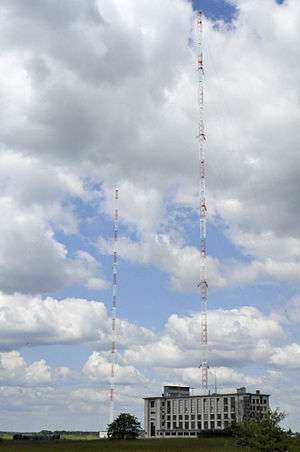Allouis longwave transmitter
The Allouis longwave transmitter first entered service, as France's central longwave transmitter, in 1939. It is located near the village of Allouis.

Prior to its destruction in 1944 by German forces, it used an aerial with four masts and a transmitter rated at 500 kilowatts.[1]
On 19 October 1952 a new 250 kW transmitter came into service. This used a special cage aerial, mounted on a 308-metre high earthed mast. In 1957 the transmission power was increased to 600 kW, in 1974 to 1000 kW, and in 1981 to 2000 kW. Transmission power is reduced to 1000 kW during the hours of darkness.
In 1974 the aerial was renewed. The cage aerials were removed and the mast height was increased to 350 m. A second mast of the same height was constructed at the same time. Since 1977 the Allouis transmitter in Allouis has been used to transmit not only the France Inter radio channel, but also a phase modulated time signal.
The transmitter initially operated on 164 kHz, but this was changed to 163.840 kHz (the 5th harmonic of the common 32768 Hz timekeeping frequency) in 1977 to be a more convenient frequency standard.[2]
In 1980, the first atomic clock was installed to regulate the carrier frequency.[2]
On 1 February 1986, the frequency was changed to its current value of 162 kHz (still an accurately controlled frequency standard) to bring it to a multiple of 9 kHz in accordance with the Geneva Frequency Plan of 1975.
The French government has announced plans to discontinue operating this station at the end of 2016.
References
- ↑ (French)Chronologie des radios françaises en ondes longes 1921–2000 ("Chronology of french long-wave transmitters 1921–2000")
- 1 2 (French)Les ré-orientations
External links
- France Inter Radio Masts at Structurae
- (French) http://perso.wanadoo.fr/tvignaud/am/allouis/fr-allouis.htm
- http://www.skyscraperpage.com/diagrams/?b44247
- http://skyscraperpage.com/diagrams/?b58020
Coordinates: 47°10′10.5″N 2°12′16.5″E / 47.169583°N 2.204583°E